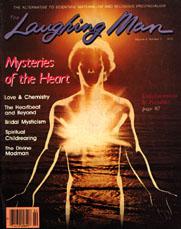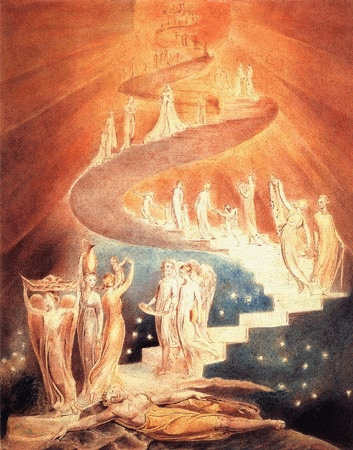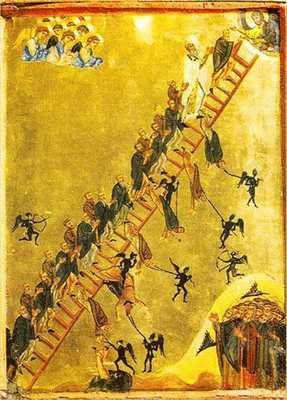
Awakening to the
Self
Laughing Man Magazine, Vol. 4,
1983
Introduction – Stage
Six
The
physiology of the human body is a difficult subject that,
despite recent advances in medicine and biology, still has
its enigmas. However, the “subtle physiology” proposed in
the esoteric traditions escapes our comprehension altogether
so long as we do not directly experience it. Also, it cannot
mean anything to us unless we are willing to assume the
possibility that our body is in fact a multidimensional
reality.
This assumption is a basic premise
in all the esoteric or spiritual schools. What is more, it
is beginning to be confirmed by modern disciplines such as
biology, quantum physics, and parapsychology. Thus, the
British biologist Rupert Sheldrake recently caused a stir in
and outside scientific circles with his newly formulated
theory of “formative causation.” He introduced the concept
of “‘morphogenetic fields” to account for the fact that the
growth of living organisms is an orderly affair.1
In his view, these organizing “fields” exist outside the
space-time framework. (In other words, they are
“metaphysical” realities, or hidden or esoteric dimensions
of the physical being.) This notion meshes with the
quantum-physical idea of an “implicate order” developed by
Professor David Bohm in his celebrated work Wholeness and
the Implicate Order. According to this theory, the world or
existence as such is to be viewed as a total process in
which every thing is “enfolded” or “implicated” in every
other thing.
Such hypotheses and models are
important breakthroughs and breaks with the mechanistic
world-view of scientific materialism. Yet, they are only
positive and hopeful beginnings. Generally speaking, though,
modern science lags considerably behind the visionary models
of the esoteric traditions and the unique comprehension by
the Great Adepts of the complexities of the world process.
But, to be sure, there is a growing convergence between the
speculations of the “new science” and the advanced models of
the spiritual traditions. If the Adepts of the past lacked
the kind of conceptual sophistication that would impress
today’s scientists, modern science is hampered by the fact
that it does not have direct access to the ever more obvious
“spiritual” realities of which it speaks. In his Foreword to
Adi Da Samraj Free John’s magnificent volume on death and
dying, recently released under the title of Easy
Death, Professor Kenneth
Ring observes that Adi Da Samraj “is transmitting to us the
greater meaning of what near-death research has only dimly
seen.” With this remark he acknowledges the Adept’s superior
“research methodology,” which is not inference or
speculation but direct apprehension and insight into the
dimensions of existence that still (and may forever) lie
outside the capacities of science.

In this light, we offer the
following summary of Adi Da’s disclosures about Man’s
esoteric anatomy or physiology with special reference to the
structure known as the “heart.” In the present context, we
are able to focus only on some of the significant details.
For a complete and thorough understanding of this
subject-matter, we refer our readers to Adi Da Samraj
published Teaching, notably The
Enlightenment of the Whole Body
and The
Paradox of Instruction.

The traditional model of spiritual
practice is the vertical path: the ascent to ever higher and
subtler regions until the final, unsurpassable Goal is
attained. In the Judeo-Christian
tradition the primary image
of ascent is Jacob’s ladder, which has its base on earth and
its topmost rungs in heaven. The historical origin of this
image was in Jacob’s (Old Testament) vision of a ladder,
complete with ascending and, descending angels, stretching
from the physical earth to the starry firmament.

However, when this picture is
regarded in the light of the traditional esotericism of the
East, the ladder is seen to be an archetypal description of
the central nervous system of Man, or the “Energy” which it
reflects. In this view, the spinal column and brain form the
frame of an esoteric ladder of Energy (the Current
of Life) that is felt to
rise into subtler and subtler realms of
experience.
This esoteric account of the nervous
system and its underlying subtle “energetic” functions is
given its clearest expression in the cakra2 model
of Hinduism and Tantric Buddhism. In this model, the spinal
axis is seen to be constituted of a hierarchical series of
(generally seven) energy centers ascending from the base of
the spine, or the perineum, to the crown of the head. The
centers are associated with but not identical to various
nervous structures of the spinal column and
brain.

Thus, we have:
1) the muladhara cakra, located at
the perineum and associated with unconsciousness, or the
state of sheer physical existence prior to self-conscious
awareness;
2) the svadhishthana cakra, situated
at the level of the sex organs and associated with the
emotional-sexual being and subconsciousness;
3) the manipura cakra, located at
the level of the great abdominal region from the navel to
the solar plexus and associated with intention, waking
consciousness, and the gross body as a whole;
4) the anahata cakra, found at the
level of the heart and associated with the psychic,
intuitive, feeling aspect of the being and the transition
from the gross physical dimension to the subtle, mental
dimension;
5) the vishuddha cakra, situated at
the level of the throat and associated with the verbal
mind;
6) the ajna cakra, located at the
brain core and associated with higher psychic super
consciousness;
7) the sahasrara cakra, situated at
(or above) the crown and associated with supramental
consciousness.
Traditionally, these cakras, or
centers of consciousness, are connected by three subtle
“pathways” or “currents” – ida, pingala, and sushumna. Ida
and pingala are a polarized pair of currents, or the two
poles of a single current. They twine about the spinal axis,
meeting and crossing at the cakras. Pingala, or the current
associated with the right side of the body, is “positive in
charge (‘yang’), sun-like or hot, stimulated and
stimulating, and centrifugal (outward, expansive) in
tendency.”3 Ida, associated with the left side,
is “negative in charge (‘yin’), moonlike or cool, calm and
calming, and centripetal (inward, contracting, centralizing)
in tendency.”4
The third current, sushumna,
represents the equanimity, harmony, or union of the two
polar currents of ida and pingala. It is the central current
that runs between the twin currents, coincident with the
core of the spinal line. While the currents of ida and
pingala are associated with the polarized play of opposites
in the gross physical dimension, the single, balanced
current of sushumna is connected to the harmonized play of
energy and mind in the subtle, spiritual dimension. It is
the vehicle of the more advanced or esoteric processes of
traditional yogic and mystical spirituality, in which
attention is directed inward and upward to the light
contacted at the topmost center.

The Heart
However, in the ultimate extreme of
ascent, the Life-Current does not terminate above or at the
crown of the head, as most traditions teach. The traditional
view is incomplete. As Adi Da Samraj explains, the Current
falls in an S-shaped curve into the right
side of the heart, the root
of attention. Thus, there exists a third vertical structure
beyond the twin currents of ida and pingala, and the single
current of sushumna. This S-shaped current that runs between
the center at (or above) the crown of the head and the right
side of the heart is the vertical structure corresponding to
the causal, formless dimension of thoughtless, bodiless pure
awareness.
As Adi Da Samraj points out, within
this description of the vertical structure of the body-mind
the heart plays a central role. It is the dividing point
between what is above and subtle and what is below and
gross. The three centers below the heart are connected with
the various functions of the gross physical being:
vital-physical, emotional-sexual, and verbal-intentional
activity. The three centers above the heart are associated
with the functions of the ascended, subtle being: mental
(verbal), higher mental (comprehending), and supramental
(intuitiverealizing). The heart center itself is the
feeling, psychic core of the whole body, expressing the
unity of the body-mind.
The heart is the center of both the
upper and lower coils of the being:
“The structure on which the whole
body rests is shaped like a seahorse. The heart and trunk is
its prominent and controlling center or horizontal median.
Extending from it vertically are two coils. One passes down,
through the solar plexus, behind the navel, to the lower
back, then coils forward, through the anus, perineum, and
sex organs, into the front of the navel, and comes to rest
in the deep core of the lower body (between the navel and
the sex organs and above the perineum). It also includes the
legs, or lower extremities. The other coil extends above,
through the throat, to the lower rear of the brain, then
coils forward along the line of the crown, down behind the
forehead, up into the mid-brain, and comes to rest in the
deep core of the head, above the level of the eyes, and
below and slightly forward from the aperture or dent in the
upper crown. It also includes the arms, or upper
extremities. Manifest existence, as it is communicated in
Man, is the play within and between the conditions inherent
in the milieu of these two coils.
“5
However, the heart, the central
locus of the two coils of the being, is not to be identified
exclusively with the anahata cakra. The Teaching of Adi Da
provides a unique description of the “heart” as a complex
horizontal structure of the body-mind. The “heart,” which is
not to be equated simply with the physical organ,. is the
“horizontal foundation” of Man. s such, it is senior to the
vertical structures of ida, pingala, sushumna, and the
S-shaped current descending to the right side of the heart.
Just as the vertical structures are evolutionary, dualistic,
and linear–ascending toward subtler and subtler theatres of
experience-the horizontal structure of the heart is prior,
unitary, and central. It is the structural core of the three
conventional states of awareness (waking, dreaming, and deep
sleep) and the locus or root of egoic differentiation
itself.

As Adi Da Samraj explains, the great
horizontal structure of the heart contains within it a
hierarchy of three substructures or loci associated with the
three states of waking, dreaming, and deep sleep. Each of
these loci also relates directly to one of the three
vertical dimensions or realms of manifest experience: the
gross physical dimension, the subtle, spiritual dimension,
and the causal, formless dimension of manifest consciousness
without subtle or gross appearances. Similarly, each locus
of the heart relates to a corresponding vertical structure
connecting it to the two vertical coils of the
being.
The physical heart is not situated
in the center of the chest, but is tilted slightly so that
its bulk lies mainly to the left of and below the center of
the chest. Likewise, the . first structural locus of the
heart is found on the left, epitomized by the physical bag
of the heart. Esoterically speaking, the left side of the
heart is associated with the waking state, the vertical
structure of ida and pingala, and the attachment of
attention to gross physical objects or its diffusion
throughout the gross body. Additionally, ‘:the heart on the
left is linked up with the manipura and vishuddha cakras,
the centers of the intentional, waking consciousness and the
verbal mind.
The second structural locus of the
heart is located in the middle of the chest, the region of
the thymus gland and the anahata cakra. It is associated
with the dreaming state, the subtle body, and the attachment
of attention to subtle and mental states, mystical
phenomena, dreamlike conditions, brain phenomena, and
internal sensory states. The middle region of the heart is
also associated with the svadhishthana and ajna cakras, the
centers of the subconscious and the superconscious
mind.
The third and most senior structural
region of the heart is to be found on the right side, in the
region of the sinoatrial node (or pacemaker) in the right
atrium of the physical heart. The region of the right side
of the heart is associated with deep sleep, the causal,
formless dimension, and the root of attention. Additionally,
the heart on the right is related to the muladhara and
sahasrara cakras, the centers of premental and supramental
consciousness.
The region of the right side of the
heart is the locus of the paradoxical association between
the self and the Self. At the same time, it is the terminus
of the vertical structure of ascent. The traditional
explanation of the vertical structure of the body-mind is
self-based. It depends on the manipulation of attention,
directing it inward and upward. But when attention falls
into the right side of the heart, then attention is
transcended in its Source. and the self is Realized as the
Self.
Ultimately and paradoxically, the
right side of the heart is realized not to be a place at
all. From the point of view of the body mind, the right side
of the heart is the origin of self-differentiation, the root
of the mechanism of attention that is the ego. But when
attention is transcended at its root, the Self is Realized
beyond all of the structures of the body-mind, beyond
association with any place. Thus, to paraphrase Adi Da , the
Self is not seated in the right side of the heart, or
anywhere else. The
heart on the right is the
reference point of the self-knot, not the locale of the
Self. Reality is not contained in either the vertical or the
horizontal structures of the body-mind. It is the
Transcendental Condition of both.
The typical yogin or mystic
practicing in the sixth stage of life seeks to maintain
identification with the Self by excluding attention from its
objects, thereby resting in the root of attention in the
right side of the heart. “In other words, association with
the Self is still ego-based, or based in the individuated
consciousness. Apart from the effort of exclusion, the
intuition of the Self is lost.”6 It is only when
the motive of exclusion is released, in the seventh stage of
life, that the Transcendental Self is simply and directly
Realized in perfect Sacrifice, with “open eyes,” to be the
native Condition, not dependent on the efforts of the
ego.
In the seventh stage of life the
heart on the right is no longer the means or locus for
penetrating the root of attention in Self Realization. It is
the means or locus for recognizing conditional existence as
“Only God.” The current between the sahasrara and the heart
is then regenerated without the separate self-sense. This is
Amrita Nadi, the Current in which the self and all worlds
are recognized and Outshined. “It is the Heart itself, prior
to ego, mind, life, body, and worlds. It neither excludes
nor includes any arising. It is Radiance itself, which
pervades all things, is all things, and which is eternally
unchanged.”7
1. See A New Science of Life: The
Hypothesis of Formative Causation, by Rupert Sheldrake (Los
Angeles: J. P. Tarcher. 1981).
2. The Sanskrit word cakra, often
spelled “chakra” in English, means literally “wheel,” which
is in reference to the “revolving” energy foci as which the
cakras disclose themselves to the yogin’s inner
vision.
3. [Da] Free John, The
Paradox of Instruction (San Francisco: The Dawn Horse Press.
1977), p. 226.
4. Ibid.
5. ibid., p. 225
6. Excerpted from a talk given by Da
Fee John on January 26, 1983.
7. The Paradox of Instruction, pp.
235-37.
Suggested Readings Related to the
Sixth Stage of Life
Maharshi, Bhagavan Sri Ramana,
trans. by A. R. Natarajan. Sat-Darshana (Forty Verses on
Reality). Bangalore: Ramana Maharshi Centre for Learning,
1982.
Osborne, Arthur, ed. The Collected
Works of Ramana Maharshi. New York: Samuel Weiser and Co.,
4th ed., 1966.
Radhakrishnan, S., trans. The
Principal Upanisads. London: George Allen and Unwin,
1974.
Vidyaranya, Swami, trans. by Hari
Prasad Shastri. Panchadasi: Treatise on Advaita Metaphysics.
London: Shanti Sadan, 2d ed., 1965.